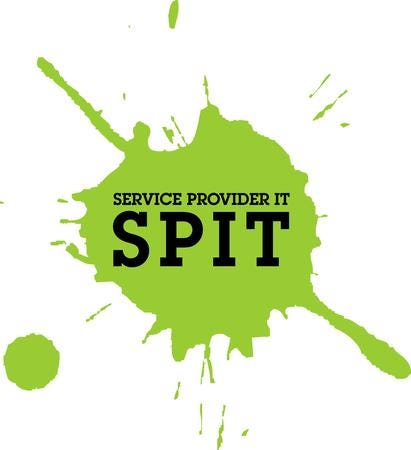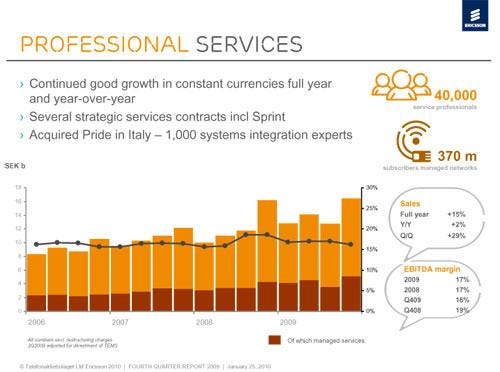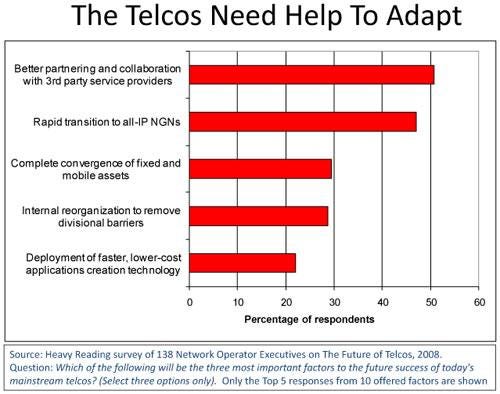The SPIT Manifesto
Service provider IT (SPIT) is critical to the future growth, even survival, of communications service providers – SPIT IS IT!
February 10, 2010

If Bob Dylan were a communications services industry analyst (ed. note: worst premise ever?), he'd be re-releasing 1964's The Times They Are a-Changin' on a very frequent basis, as well as writing new, in-depth reports (in the key of D minor) about the IT revolution that's shaking up the telecom sector.
Why? Well, there are the royalties, naturally – the likes of Dylan have lifestyles to maintain.
Also, and more seriously, the availability (and affordability) of new technologies; the uptake of mobile devices and services; customer behavior patterns; regulations; and the introduction of new, competitive service models – particularly from the online community and game-changers like Apple, with its App Store – have shifted the sector's power base.
All of those changes, and how they are affecting service providers of all kinds – traditional fixed line, wireless, cable – are well documented, on the Light Reading Group's Websites and elsewhere.
What is not as well documented, though, is the impact those changes have had behind the scenes at the operators, and how service providers of all types have had to spend a great deal more time, effort, and resources (human and capital) on figuring out the role of non-traditional telecom infrastructure in their new strategies.
Everyone can see that the network operators of the world are undergoing major infrastructure and business strategy transformations: the migration to IP; the growing reliance on outsourcing (managed services); and the need to introduce new services and applications (increasingly delivered from hosted platforms)... are just some of the notable trends.
That transformation process, though, means that network operators, in addition to all the other changes and pressures they have to deal with, have had to re-assess their deployment and strategic use of operations and business software, applications creation systems, service delivery capabilities, and supporting IT infrastructure.
Or, put more simply, they need a strategy for Service Provider IT – or SPIT.
SPIT: What is it?
What is Service Provider Information Technology? It's the evolving set of non-traditional telecom (and data networking) technologies that allow for a greater degree of flexibility in the creation, management, delivery, and monetization of new-generation communications services.
(Find out more at our SPIT site, where you can download a SPIT Infographic.)
And a SPIT strategy is absolutely vital to the key goals that all service providers have today: developing and monetizing new services and applications; cutting costs; migrating to next-generation networks; and improving customer care and the customer's experience.
Rise of the CIO
The growing importance of SPIT at service providers is increasingly evident. For example, one major telecom operator, U.K. incumbent and international heavyweight BT Group, has put its CIO in charge of all technology matters, and it's killed off the traditional CTO role, in July 2009 when Matt Bross jumped across the operator/vendor divide to join Huawei Technologies Co. Ltd.
Commenting on that particular news, Heavy Reading chief analyst Graham Finnie notes that, while "the CTO still has the upper hand in most telcos" in terms of taking technology decisions and driving the network strategy, "the power is shifting towards the CIO... as the center of gravity in telcos shifts towards IT. This move looks like a reflection of BT's strategy to position itself as a company that's providing the network as a service, using next-generation OSS and opening up its network to third parties."
And the increasing influence of CIOs within service providers is also evident. A recent Heavy Reading survey of carrier executives found that the CIO, rather than the CTO, was regarded as the key decision-maker and influencer "for the definition and acquisition of technology that enables stronger linkages with third-party service providers."
This isn't a "Big Bang" change, though. The growing importance of IT systems within service provider strategies has been evident for a number of years, but has accelerated notably during the past 12 to 18 months. And Light Reading has been writing about SPIT developments for years, tracking developments in the OSS world, charting the service delivery platform (SDP) wave, and reporting on the growing importance of managed and hosted services, for example.
Up to now, though, these topics have been treated in virtual isolation, and not as part of a broader, clearly identified shift within the industry. SPIT brings all these things together.
What Light Reading is doing with its own SPIT strategy (of which this brief manifesto is the opening gambit) is to highlight the growing importance of service provider IT, and identify and write (and talk) about the technologies, companies, teams, individuals (the "Big Spitters"), and investments related to SPIT – because carriers are definitely coughing up for SPIT.
Now, just to be clear, we're not saying that network infrastructure is less important, or doesn't matter. That would be ludicrous – the kind of thing we'd only say (along with a lot of other gibberish) after seven or seventeen Caipirinhas. Developments in fixed and mobile access, backhaul, carrier Ethernet, metro and long-distance transport, and many other areas, are still absolutely critical to the future of all communications service providers.
What we are saying, though, is that the SPIT elements are now equally important.
As a result, every communications service provider has some vital decisions to make right now about the SPIT systems it needs in order to create, deliver, and manage the services it will offer for the next few years. Whether selling to consumers, enterprises, governments, other service providers, content owners, or applications developers, the SPIT systems underpinning a service provider’s business strategy have never been more critical. The decisions that service providers make about their SPIT strategies could unleash unprecedented value for service providers, but, if handled poorly, it could put them years behind their competitors, jeopardizing billions of dollars in revenue and hundreds of thousands of jobs.
Heavy, huh?
So, in the following pages we will outline what we're including in the SPIT domain, and how it's linked to the key service provider trends.
We also need to note two things. First, that SPIT is already a term used by a sub-section of our industry, where it stands for SPAM over Internet Telephony. We don't foresee any confusion.
Second, for those of you who have become attached to Light Reading's very own Larry the Monkey over the years – don't worry, he's not being replaced by Spit, the Dog.
Of course, what we want from you, our esteemed readers, is feedback, suggestions, comments, and (never a day goes without it) some mild abuse/ribbing about this manifesto.
Page 2: The SPIT Elements
— Ray Le Maistre, International Managing Editor, Light ReadingNext Page: The SPIT Elements
So what are these elements? In a nutshell:
OSS and BSS (operations and business support system) software
At Light Reading, we've broken down this part of the market into a number of categories:Activation
Billing systems
Customer relationship management
Data integrity
Element management systems
Fault management
Inventory management
Mediation systems
Middleware
OSS test & measurement
Performance monitoring
Planning tools
Product management
Provisioning
Revenue assurance & fraud management
Service management
Notable names in this sector (in which hundreds of companies are active) include Agilent, Amdocs, CA, Convergys, HP, IBM, Oracle, and Telcordia, along with the major equipment vendors such as Alcatel-Lucent, Ericsson, Huawei Technologies, and Nokia Siemens Networks.
SDPs (service delivery platforms)
A tough category to pin down, as there is no agreed upon, standardized definition. Basically, though, SDPs comprise a collection of standard and specialized IT components that, together, can provision and charge for new services, and are designed to reduce the cost and time of developing and deploying new services and applications. Currently, SDPs are often linked to operator attempts to build symbiotic environments that enable them to provision services and applications that are provided by third-party content owners and/or developed by third-party software vendors.
Notable names in this sector include Accenture, Aepona, Alcatel-Lucent, Amdocs, CA, Compuware, Ericsson, HP, Huawei, IBM, NSN, and Telcordia.
We also include "service brokers" in this category. These are (take a deep breath...) network software platforms of various types that essentially allow telecom services and network functions to interact across different technology domains (traditional IN, IMS, and Web), and also to allow new applications to be developed and offered by both network operators and, eventually, third parties in a converged, open environment.
Companies that have developed service brokers include Aepona, AppTrigger, Convergin, Mavenir Systems, Motorola, Opencloud, Tekelec, and Veraz Networks, among others.
IMS (IP Multimedia Subsystem) elements
We're including the control plane and service plane components of IMS, including application servers, charging systems, policy control servers (Policy and Charging Rules Function, or PCRF), and subscriber management servers (Home Subscriber Server, or HSS), in our SPIT taxonomy.
Vendors in this category include all the major equipment suppliers, plus specialists such as Bridgewater Systems, Camiant, and Openet.
Security tools/platforms
This category includes user authentication and URL filtering (closely linked to policy control), firewalls, and denial-of-service defences. These are particularly relevant here because these tools are now being used to provide hosted services for service provider customers (security as a service) as well as protecting the service provider and its customers.
Cloud/virtualization/hosted services platforms
We're restricting this category to the systems that are of specific relevance to service providers that are looking to offer cloud-based services to their customers. Cloud services deployments include a lot of generic IT, including server technology, but also encompass the critical virtualization tools that enable service providers to aggregate their resources and offer them as services. These are also, of course, vital to service providers' managed services capabilities (where they run enterprise IT systems on an outsourced services basis).
Currently, VMware and shared storage specialist NetApp have emerged as notable specialist technology providers to the telecom world's cloud enthusiasts.
Managed services platforms
This isn't so much a technology category as an integrated SPIT deployment scenario, but worth mentioning. Managed services, whether offered by service providers or vendors, involve the coordinated deployment of a number of elements from the categories above, but also include specific tools for enabling self-service monitoring and provisioning and, using portals, the ability to create real-time views of service and network performance.
Next page: Industry Trends & the SPIT Connection
In this section we elaborate briefly on a key set of service provider goals that couldn't be achieved without the advancement, development, and intelligent deployment of SPIT technologies.
It's also worth noting that the increasing relevance and importance of SPIT will likely have a knock-on effect on service provider personnel strategies, as most operators now need to have expertise in the deployment and management of legacy telecom, IP, and cutting-edge IT systems.
Developing and monetizing new services/applications
Gone are the days when an operator could take two years to develop a new service and roll it out (often by having to manually update TDM voice switches).
Nowadays, communications service providers need to be much more nimble and reactive, which means being able to create and manage their products (services, applications) centrally and more spontaneously, using software and mostly off-the-shelf hardware and computing resources. The competitive environment also means they need to know a lot more about how their services are working and how their customers are behaving – in real time.
This places a much greater emphasis on IT/software systems that, previously, were used for basic support functions. The physical network infrastructure is still vitally important to telco and cable network operators (it is their main differentiator and main source of revenue). But their SPIT resources are now equally as important if they are to remain competitive – you could say that the back office systems have moved to the front line.
Perhaps the most obvious example currently is the emergence of "cloud" services, whereby service providers host applications and computing capabilities in massive data centers, and their customers utilize those resources as an alternative to running their own IT and service capabilities. Service providers need massive IT and applications capabilities – server farms, virtualization software that enables resources to be aggregated and accessed securely by multiple users, the applications themselves (e.g., CRM systems, databases, ERP systems) – to offer these services.
Of course, all services/apps need to be priced, and service usage needs to be billed. This is becoming increasingly complex, especially with the introduction of mobile data services that involve revenue-sharing between partners. SPIT, again, is critical to these capabilities. To add to the drama, service providers are having a tough enough time presenting a single view of the customer across their services.
Cutting costs
Service providers need to reduce costs and increase revenues – a very tough task. Having the most appropriate SPIT capabilities can make operators more efficient by, for example: cutting back the number of traditional OSS/BSS systems being used and supported; using remote diagnostics and repair systems, and remote upgrade capabilities to reduce truck rolls; using customer portals and software support systems to reduce the need for call center resources; using software-based building blocks for service/application creation that cuts development time and enables the use of external developers.
Migrating to next-generation networks
Every network operator is engaged in the migration to new technology platforms, whether it's LTE in mobile, Docsis 3.0 in cable, or all-IP, packet/optical transport, and FTTH for fixed-line telcos. These all require complex transformation programs that involve the upgrade and introduction of SPIT systems. In mobile, for example, the introduction of policy management systems is becoming critical to operators' ability to deal with the demand for data services. In the fixed and mobile worlds, the introduction of SPIT systems known as Service Brokers is proving strategic, as they bridge the legacy and next-gen worlds, enabling continuity of existing services and the introduction of new services without the need to switch across from legacy infrastructure to new systems in one, risky move.
Improving customer care/experience
Improving the "customer experience" has become the new battleground for service providers, as they want to attract and then hold on to new customers. The only way to improve customer experience – to be able to deal with their questions and complaints efficiently, and market appropriate/relevant new services to them – is to know who the customers are, what services they use, how and why they use them, how they pay for them, whether they are profitable customers, where they are physically (increasingly a factor), and so on.
Having this information available in real time and in a format that makes sense is all down to having the right OSS and BSS capabilities – it's a SPIT issue.
Next page: SPIT's Impact on the Communications Ecosystem
The focus in this manifesto has been the identification of SPIT and its role in service provider strategies.
But, of course, all of this is critical to the vendors/partners/suppliers that work with the service providers. Increasingly, the communications systems suppliers find themselves having to provide, not just the iron that constitutes the physical network, but the operational and service-related intelligence that runs atop the network.
That means the likes of Alcatel-Lucent, Cisco, Ericsson, Huawei, Nokia Siemens, Motorola, ZTE, et al., need to be software and IT specialists, IP experts, and telecom equipment vendors. Just producing a piece of hardware isn't going to cut it in the next-generation telecom world. And Ericsson, for example, is already showing that more revenues and manpower are coming from the services realm: All of this is also relevant to the IT sector (in terms of providing IT hardware and software), applications developers (who might now get a chance to develop new services for the cable/fixed/mobile sector and have the operators as channels), and the systems integrators, who have long worked with the operators and vendors. Indeed, as our Heavy Reading surveys have show, telcos will need an ecosystem to support their SPIT initiatives:
All of this is also relevant to the IT sector (in terms of providing IT hardware and software), applications developers (who might now get a chance to develop new services for the cable/fixed/mobile sector and have the operators as channels), and the systems integrators, who have long worked with the operators and vendors. Indeed, as our Heavy Reading surveys have show, telcos will need an ecosystem to support their SPIT initiatives: And don't forget the customer: The deployment of cutting-edge SPIT technologies should provide significant benefits to enterprise customers of all sizes in particular, but also to residential users, who should all ultimately be faced with a greater choice of services, more and easier ways to pay for them, and even better customer service. We won't hold our breath, though...
And don't forget the customer: The deployment of cutting-edge SPIT technologies should provide significant benefits to enterprise customers of all sizes in particular, but also to residential users, who should all ultimately be faced with a greater choice of services, more and easier ways to pay for them, and even better customer service. We won't hold our breath, though...
— Ray Le Maistre, International Managing Editor, Light Reading
Back to Introduction
You May Also Like










